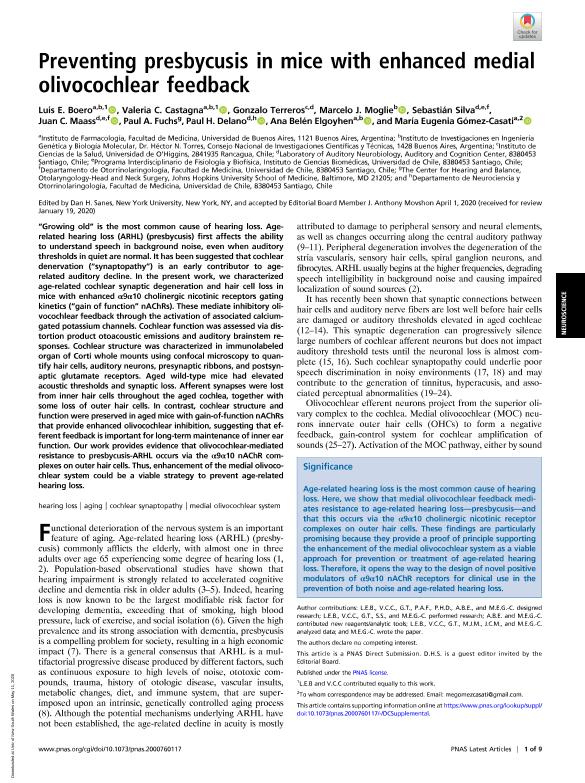Artículo
Preventing presbycusis in mice with enhanced medial olivocochlear feedback
Boero, Luis Ezequiel ; Castagna, Valeria Carolina
; Castagna, Valeria Carolina ; Terreros, Gonzalo; Moglie, Marcelo Javier
; Terreros, Gonzalo; Moglie, Marcelo Javier ; Silva, Sebastián; Maass, Juan C.; Fuchs, Paul A.; Delano, Paul H.; Elgoyhen, Ana Belen
; Silva, Sebastián; Maass, Juan C.; Fuchs, Paul A.; Delano, Paul H.; Elgoyhen, Ana Belen ; Gomez Casati, Maria Eugenia
; Gomez Casati, Maria Eugenia
 ; Castagna, Valeria Carolina
; Castagna, Valeria Carolina ; Terreros, Gonzalo; Moglie, Marcelo Javier
; Terreros, Gonzalo; Moglie, Marcelo Javier ; Silva, Sebastián; Maass, Juan C.; Fuchs, Paul A.; Delano, Paul H.; Elgoyhen, Ana Belen
; Silva, Sebastián; Maass, Juan C.; Fuchs, Paul A.; Delano, Paul H.; Elgoyhen, Ana Belen ; Gomez Casati, Maria Eugenia
; Gomez Casati, Maria Eugenia
Fecha de publicación:
26/05/2020
Editorial:
National Academy of Sciences
Revista:
Proceedings of the National Academy of Sciences of The United States of America
ISSN:
0027-8424
e-ISSN:
1091-6490
Idioma:
Inglés
Tipo de recurso:
Artículo publicado
Clasificación temática:
Resumen
"Growing old" is the most common cause of hearing loss. Agerelated hearing loss (ARHL) (presbycusis) first affects the ability to understand speech in background noise, even when auditory thresholds in quiet are normal. It has been suggested that cochlear denervation ("synaptopathy") is an early contributor to agerelated auditory decline. In the present work, we characterized age-related cochlear synaptic degeneration and hair cell loss in mice with enhanced α9α10 cholinergic nicotinic receptors gating kinetics ("gain of function" nAChRs). These mediate inhibitory olivocochlear feedback through the activation of associated calciumgated potassium channels. Cochlear function was assessed via distortion product otoacoustic emissions and auditory brainstem responses. Cochlear structure was characterized in immunolabeled organ of Corti whole mounts using confocal microscopy to quantify hair cells, auditory neurons, presynaptic ribbons, and postsynaptic glutamate receptors. Aged wild-type mice had elevated acoustic thresholds and synaptic loss. Afferent synapses were lost from inner hair cells throughout the aged cochlea, together with some loss of outer hair cells. In contrast, cochlear structure and function were preserved in aged mice with gain-of-function nAChRs that provide enhanced olivocochlear inhibition, suggesting that efferent feedback is important for long-term maintenance of inner ear function. Our work provides evidence that olivocochlear-mediated resistance to presbycusis-ARHL occurs via the α9α10 nAChR complexes on outer hair cells. Thus, enhancement of the medial olivocochlear system could be a viable strategy to prevent age-related hearing loss.
Palabras clave:
AGING
,
COCHLEAR SYNAPTOPATHY
,
HEARING LOSS
,
MEDIAL OLIVOCOCHLEAR SYSTEM
Archivos asociados
Licencia
Identificadores
Colecciones
Articulos(INGEBI)
Articulos de INST.DE INVEST.EN ING.GENETICA Y BIOL.MOLECULAR "DR. HECTOR N TORRES"
Articulos de INST.DE INVEST.EN ING.GENETICA Y BIOL.MOLECULAR "DR. HECTOR N TORRES"
Articulos(OCA HOUSSAY)
Articulos de OFICINA DE COORDINACION ADMINISTRATIVA HOUSSAY
Articulos de OFICINA DE COORDINACION ADMINISTRATIVA HOUSSAY
Citación
Boero, Luis Ezequiel; Castagna, Valeria Carolina; Terreros, Gonzalo; Moglie, Marcelo Javier; Silva, Sebastián; et al.; Preventing presbycusis in mice with enhanced medial olivocochlear feedback; National Academy of Sciences; Proceedings of the National Academy of Sciences of The United States of America; 117; 21; 26-5-2020; 11811-11819
Compartir
Altmétricas



